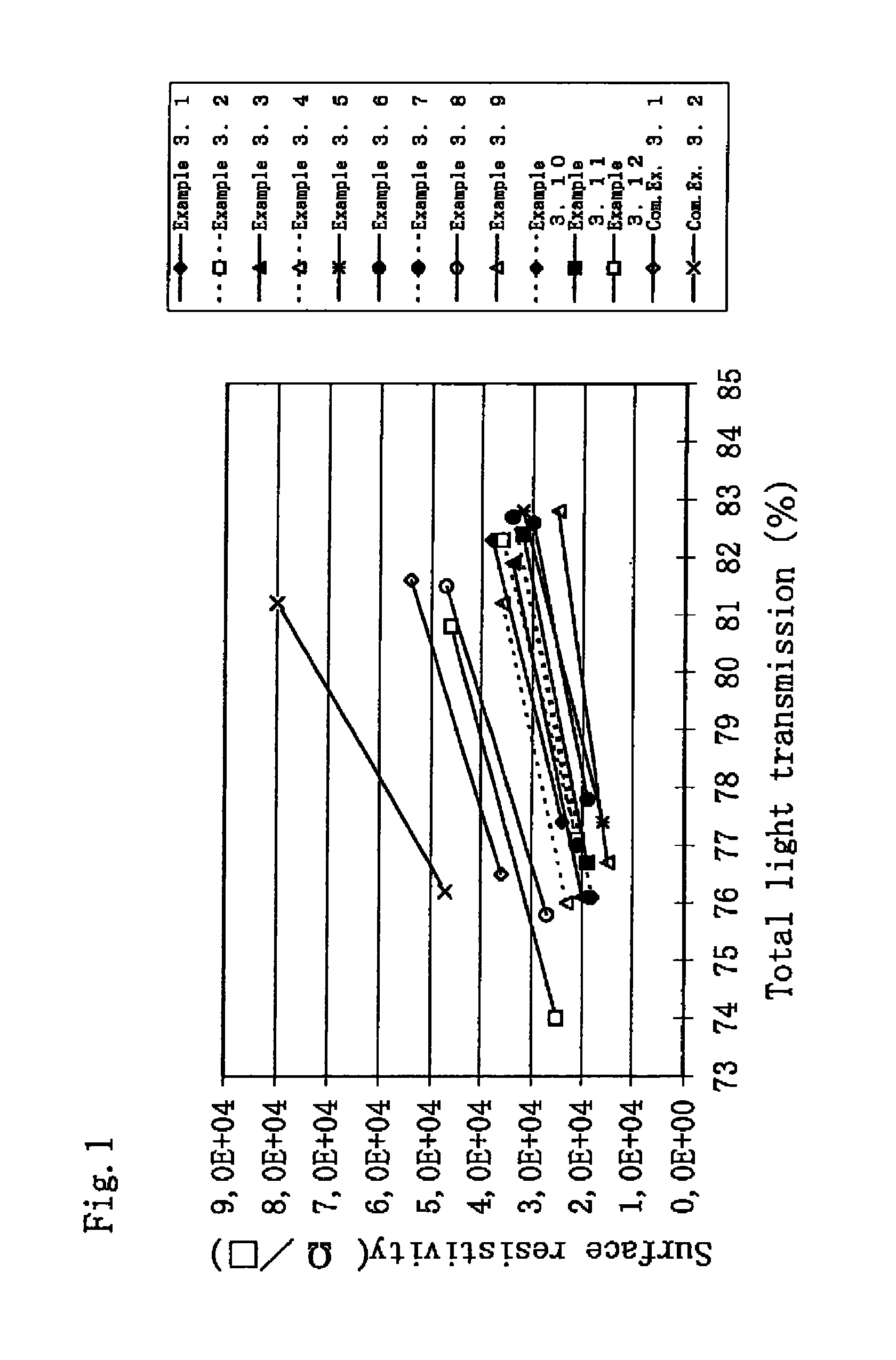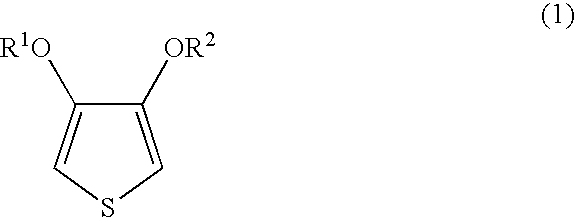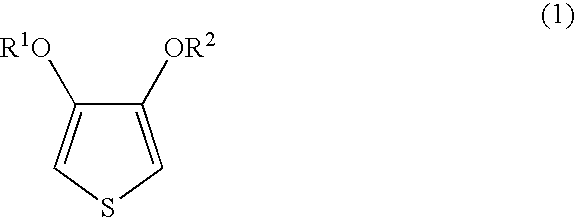Method for producing an aqueous dispersion containing a complex of poly(3,4-dialkoxythiophene) and a polyanion
a technology of aqueous dispersion and complex, which is applied in the direction of electrically conductive paints, conductive materials, conductors, etc., can solve the problems of high cost of film formation, high temperature of film formation, and inability to produce haze values, etc., and achieves excellent transparency and conductivity, easy formation, and easy production
- Summary
- Abstract
- Description
- Claims
- Application Information
AI Technical Summary
Benefits of technology
Problems solved by technology
Method used
Image
Examples
example 1.1
[0057]VERSA-TL125 manufactured by Nippon NSC Ltd. was subjected to ultrafiltration using Biomax-100 manufactured by Millipore Corporation, and then was subjected to cation exchange, and diluted with deionized water, so that 1,887 parts of an aqueous solution containing 22.2 parts of polystyrenesulfonic acid (weight average molecular weight: 175,000; sulfonation degree: 100%) was obtained. To this aqueous solution, 49 parts of a 1% iron (III) sulfate aqueous solution, 30 parts of concentrated nitric acid solution, 8.8 parts of 3,4-ethylenedioxythiophene and 121 parts of a 10.9% peroxodisulfuric acid aqueous solution were added. The pH of the reaction mixture at this time was 0.82. This reaction mixture was stirred at 18° C. for 19 hours. Then, 154 parts of cation exchange resin and 232 parts of anion exchange resin were added to the reaction mixture and stirred for 2 hours. Thereafter, these ion exchange resins were filtered off so that a deionized aqueous dispersion (2,033 parts: so...
example 1.2
[0058]9X-402 manufactured by Nippon NSC Ltd. was subjected to ultrafiltration using Biomax-100 manufactured by Millipore Corporation, and then was subjected to cation exchange, and diluted with deionized water, so that 1,887 parts of an aqueous solution containing 22.2 parts of polystyrenesulfonic acid (weight average molecular weight: 282,000; sulfonation degree: 100%) was obtained. To this aqueous solution, 49 parts of a 1% iron (III) sulfate aqueous solution, 30 parts of concentrated nitric acid solution, 8.8 parts of 3,4-ethylenedioxythiophene and 121 parts of a 10.9% peroxodisulfuric acid aqueous solution were added. The pH of the reaction mixture at this time was 0.81. This reaction mixture was stirred at 18° C. for 19 hours. Then, 154 parts of cation exchange resin and 232 parts of anion exchange resin were added to the reaction mixture and stirred for 2 hours. Thereafter, these ion exchange resins were filtered off so that a deionized aqueous dispersion (2,056 parts: solid c...
example 1.3
[0059]9X-309 manufactured by Nippon NSC Ltd. was subjected to ultrafiltration using Biomax-100 manufactured by Millipore Corporation, and then was subjected to cation exchange, and diluted with deionized water, so that 1,887 parts of an aqueous solution containing 22.2 parts of polystyrenesulfonic acid (weight average molecular weight: 460,000; sulfonation degree: 100%) was obtained. To this aqueous solution, 49 parts of a 1% iron (III) sulfate aqueous solution, 30 parts of concentrated nitric acid solution, 8.8 parts of 3,4-ethylenedioxythiophene and 121 parts of a 10.9% peroxodisulfuric acid aqueous solution were added. The pH of the reaction mixture at this time was 0.84. This reaction mixture was stirred at 18° C. for 19 hours. Then, 154 parts of cation exchange resin and 232 parts of anion exchange resin were added to the reaction mixture and stirred for 2 hours. Thereafter, these ion exchange resins were filtered off so that a deionized aqueous dispersion (2,048 parts: solid c...
PUM
| Property | Measurement | Unit |
|---|---|---|
| temperature | aaaaa | aaaaa |
| temperature | aaaaa | aaaaa |
| temperature | aaaaa | aaaaa |
Abstract
Description
Claims
Application Information
 Login to View More
Login to View More - R&D
- Intellectual Property
- Life Sciences
- Materials
- Tech Scout
- Unparalleled Data Quality
- Higher Quality Content
- 60% Fewer Hallucinations
Browse by: Latest US Patents, China's latest patents, Technical Efficacy Thesaurus, Application Domain, Technology Topic, Popular Technical Reports.
© 2025 PatSnap. All rights reserved.Legal|Privacy policy|Modern Slavery Act Transparency Statement|Sitemap|About US| Contact US: help@patsnap.com



